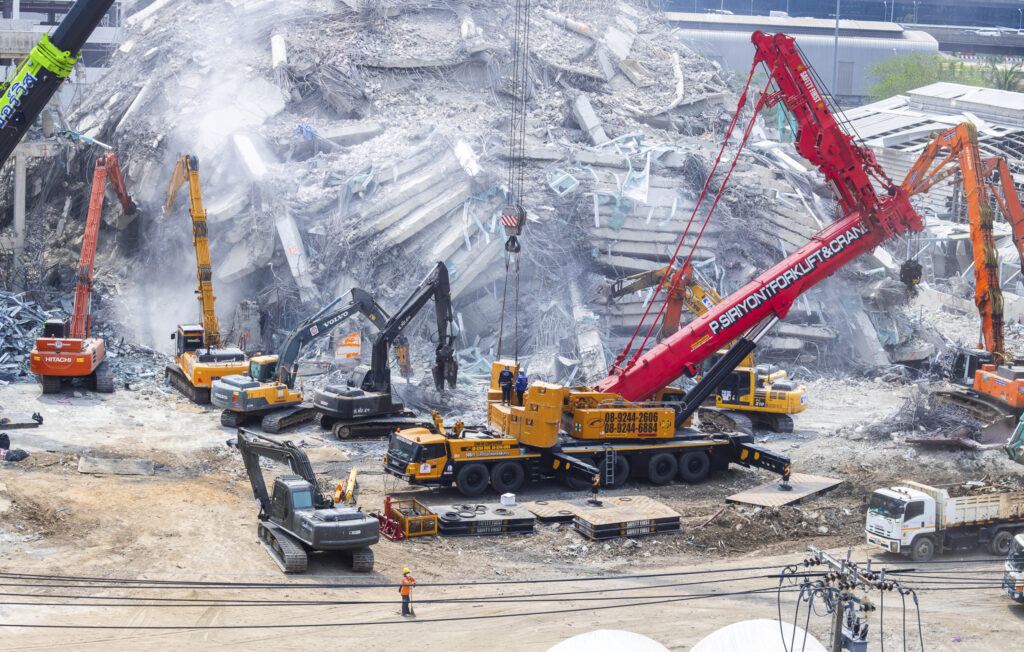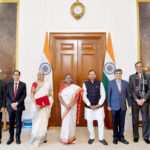When a powerful 7.7-magnitude earthquake struck Myanmar and Thailand on March 28, 2025, one Washington, DC-area non-governmental organization (NGO) sprang into action: Airlink.
In all disasters, time becomes the biggest challenge to overcome. Whether a fire, flood, or flurry of storms, immediacy is key to survival of communities affected, and mitigating the effects that can rapidly compound rescue, recovery, and rebuilding.
On March 28th, 18.3 million people were made vulnerable the moment the earthquake struck—and the race against the clock started to save those buried, as well as restore power and running water. The death toll is currently over 3,600, with experts warning it could reach 10,000; over 40,000 homes were damaged or destroyed.
It wouldn’t be easy to transport help between cities and within the Southeast Asian country of Myanmar. The air traffic control tower collapsed at the main airport in Myanmar’s capital, Naypyitaw, taking several lives with it; surrounding smaller airports saw runways blocked or ruined from the earthquake. Cities in the mountains reported seeing their land liquify as a result of groundwater rising after the tectonic shift.
Between the thousand-year-old temples that collapsed, and the infrastructure at large destroyed, it became clear that the Myanmar government needed to call on aid from the international community: something it hasn’t done in over a decade and not since the civil war broke out in 2021.

Airlink is a disaster-response NGO that specializes in delivering humanitarian aid on behalf of charities by leveraging airline partners that offer donated space for passengers and aid cargo on existing routes. The organization has been actively responding to disasters for fifteen years, after launching its full-scale operations to Haiti following the earthquake in 2010. Airlink found its niche in the humanitarian sector: coordinating logistics so others can focus on procurement of materials and implementing the aid.
The supply chain can make up for 73 per cent of an organization’s budget, and Airlink’s mission is to alleviate that financial, logistical and staffing burden. Airlink gained even more experience with earthquake response after the Türkiye-Syria earthquake in 2023, when Airlink coordinated flights for 230 passengers; a huge lift for dozens of organizations.
All NGO partners who request airlift and logistics coordination from Airlink are vetted and must verify that their resources being sent are indeed needed on the ground by an identified recipient in position in Myanmar. The process is carefully reviewed by the organization to meet the airline safety standards and regulations, and so the materials can clear customs upon arrival and be distributed in a timely manner.
But this operation quickly becomes expensive. Earthquakes are unpredictable disasters. While cyclone and hurricane seasons are cyclical and anticipated by NGOs worldwide who can budget annually for both preparedness and disaster response, earthquakes can happen anytime or anywhere—even when conflicts or other factors are ongoing. It’s partly what makes the response both urgent and complex, and makes it critical to have all players already in place to go when needed.
Yet, the reduction of operations and budget at USAID has severely limited the funding being granted, leaving NGOs to struggle to mobilize teams and scrape together the financial means to both send humanitarian aid and transport first responders and volunteers to the affected region. This loss of funding is causing a ripple effect throughout the humanitarian sector, as organizations are trying to meet the demand, with limited funding upon which to operate.
This moment is where Airlink is emerging as a leader in the global collaborative response on a mission to save lives.
Due to the large-scale demands and extensive damage, Airlink is chartering aircraft and relying on freight forwarders to deliver by sea and truck—a cost that exceeds current estimates of budget for response—and could bring the total investment in response to over $750,000 (USD).
Airlink is focusing its campaigns on reaching out to previous and current sponsors in hope of securing greater funds for the response to help with some of the critical shipments of medical equipment to tend to the wounded and keep hospitals running, pumps to restore clean drinking water, and install temporary shelters to keep families safe.
Dry foods and communications resources are also being sent to help establish rudimentary kitchens and telecoms. There is fear that slow response or other factors may contribute to the damage and make a full recovery difficult.

Myanmar is particularly vulnerable to disasters, as it sits on a major fault line and has already seen a number of aftershocks, with much of the landscape being mountainous and rural terrain, which will be threatened by monsoons and subsequent landslides in the coming weeks when the rainy season starts. In a race against time, volunteers and communities are scrambling to clean up damaged buildings and put blockades where they are able, in anticipation of the changing season.
Prior to the earthquake, roughly 19.9 million people were estimated to already need humanitarian aid due to conflict and infrastructure risks in the country. This earthquake, considered a “once-in-a-century” event, has quickly compounded pre-existing issues and exposed more lives to the elements. This week, the United Nations stated that 2 million people urgently need attention and care, their lives immediately threatened.
Airlink is working with several global airline partners, including MASKargo, Malaysia Airlines, and United Airlines, to transport aid and first responders who are working to recover bodies and help prevent disease outbreak and mitigate starvation. Partners on-the-ground in Myanmar are receiving the aid and coordinating distribution to hospitals, community centers, and displaced families. These operations are all thanks to the generosity of individuals and companies stepping up to fill the gaps in federal funding and commit to helping devastated communities thousands of miles away.
With limited unrestricted funds already available, Airlink was able to piece together a quick response, and navigate challenging hurdles into the country and coordinate the travel logistics for over 70 passengers and 56 tons of cargo bearing aid—and was the first NGO to cross the border. Teams on behalf of seventeen organizations from the United States and around the world were able to begin their work and set up camps, staging areas, and safe spaces for the communities, and distribution points for families and individuals needing help. Palettes of aid were delivered to most-hit communities to begin production of meals and implementation of health services. All was possible because of donors who gave without restriction, so Airlink and their NGO partners could have a budget to rely on when the unpredictable disaster strikes, regardless of federal funding.
The landscape of the humanitarian and fundraising sector is changing. The earthquake in Myanmar is just the beginning, and is revealing how costly a response will be without governments funding the operations. It won’t just cost in dollars, but in lives.
In order to continue urgently responding, and prepare for the next unforeseen disaster, Airlink is seeking further donations and gifts-in-kind to increase support to their NGO partners and to help save lives. To-date, BOC Aviation and CDB Aviation are among large donors who have given funds to support Airlink.
Those who are interested are encouraged to visit Airlink’s website at airlinkflight.org to pledge a monetary gift, or donate unused air miles to the cause.
At the core of a humanitarian response is the human. As the seconds, hours, days and weeks go by, each human in Myanmar faces greater risk and danger to their life and livelihood as they wait for the next meal, a stable roof over their head, and the healthcare access they need. Each gift isn’t just a dollar—it’s a gift of hope.
Disclaimer: The opinions and views expressed in this article/column are those of the author(s) and do not necessarily reflect the views or positions of South Asian Herald.






